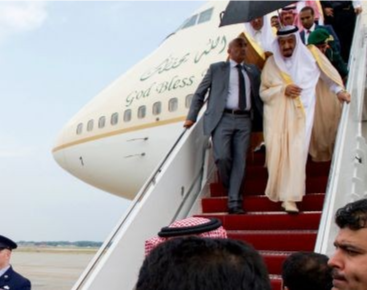
Saudi King Salman arrives in Malaysia
As the Saudi king continues his month-long travels through Asia, the tone of media coverage is worth noting. It has a thousand-and-one-nights quality, in the sense of the delightful stories about the grandeur of the eighth-century court of Abbasid caliph Harun al-Rashid.
In the case of King Salman bin Abdulaziz Al Saud, the coverage seems inordinately focused on the massive amounts of luggage and the army of people accompanying him, even though any US president would travel in a somewhat similar style. It is a side issue.
Salman is on a mission — a pivot to Asia — for sound reasons of strategic and economic importance to Saudi Arabia. Every care must be taken to ensure the 81-year-old king completes this odyssey with the maximum comfort and minimum of inconvenience. At least, that is the way the Saudis would explain this.
Perhaps goggle-eyed stupefaction over vast quantities of luggage misses the point somewhat when it is obvious that there are many complex calculations in the itinerary of this ambitious regional tour that started in Malaysia, wended its way through Indonesia and Brunei, arrived in Japan at the start of the week, then moves on to China and the Maldives and ends in Jordan.
And yet, the attention is chiefly on the king’s 1,500-person entourage and the 459 tonnes of luggage — roughly the weight of two Boeing 787 Dreamliners — rather than the less obvious diplomatic grind.
Consider the way Asahi Shimbun, one of Japan’s oldest and largest national newspapers, noted King Salman’s arrival in the country, the first by a Saudi monarch since King Faisal in May 1971. “Tokyo is having to stretch itself to roll out the red carpet for the contingent accompanying Saudi King Salman,” it said, reporting that 1,200 rooms at luxury hotels had been booked and about 400 limousines reserved with some difficulty. It went on to add that so many “luxury cars” are hard to find in Tokyo and had to be procured “from Kanagawa and Saitama prefectures as well as the Tokai region”.
Then, there are the breathless accounts in the US and British media. The Washington Post informed its readers “the world’s most powerful royal is touring seven countries with a travelling court of more than 1,000 people, including 25 princes and ten ministers. The entourage’s total baggage weighs a reported 506 tons.”
The Economist, which can be stuffy at times, was no such thing when describing preparations for King Salman’s visit to Indonesia, the first in 47 years by a Saudi monarch to the world’s most populous Muslim country. Officials had been toiling for months, it assured the world.
In Jakarta’s Istiqlal mosque, South-East Asia’s largest, where King Salman was to pray, workers installed a special toilet, the Economist confided, with “a rather high lavatory seat — 53 centimetres — with armrests on either side and a thick carpet”.
And once again, the focus on the king’s accompanying stuff: “Airport crews in Jakarta and Bali have taken delivery of 459 tonnes of equipment, including two Mercedes-Benz S600 limousines, flown in aboard four Boeing 747s, two Boeing B777s and two Hercules C-130s. The national parliament has installed a throne-like chair with impressively thick brown leather upholstery for the king to recline upon before he addresses lawmakers.”
Truly, it brought to mind the description of the nuptials of Harun al-Rashid in Kitab al-Hadaya Wa al-Tuhaf (Book of Gifts and Rarities), which offered all the awe that might be fit to print.
“For her (Zubaydah, the bride) was prepared (a banquet) the likes of which had never been prepared for any woman before her in terms of equipment, precious stones, jewellery, diadems, tiaras, silver and gold palanquins… Nothing comparable to it or to the large pearls on it had ever been seen… On its front and back there were two rows of rubies and the rest of it was of large pearls, the like of which could not be found… Al-Rashid assembled people from all the country and distributed among them an enormous amount of money… The expenses for this wedding ceremony [which were] taken from the (palace) treasury, amounted to fifty million dinars, besides what Harun spent of his own money.”
We might excuse the unknown author of the Book of Gifts and Rarities for his undue concentration on the splendour of the caliph’s wedding. It took place in 761, the peak of Abbasid power, when the royal treasury was enriched by successful military campaigns.
However, it is odd to take a blinkered view that ignores the strong political and economic subtext of the Saudi odyssey. It is clear that this is part of the roll-out of the 2-year-old so-called Salman doctrine. The once well-networked Saudi commentator Jamal Khashoggi described the doctrine as the king’s belief “Saudi interest comes first” and that it cannot link its fate to the alliance with the United States. That was true when the then-US president Barack Obama, hell-bent on a nuclear pact with Iran, was in the White House, and it is probably just as urgent a concern with the more unpredictable President Donald Trump.
In early 2015, Khashoggi defined the Salman doctrine as embracing a more proactive “alliance with its (Saudi) brothers and friends from the Arab and Muslim world”. Malaysia, Indonesia, Brunei and Maldives — all of which are Sunni-majority countries and members of the Organisation of Islamic Cooperation.
The stop in China takes care of the part of the doctrine that sees outreach to a powerful country other than the United States as a wise insurance policy. Besides, China overtook the United States as the world’s largest importer of crude oil in October 2016. Japan would help with the crucial foreign direct investment Saudi Arabia is seeking as it tries to diversify its economy.
This is no thousand-and-one-nights saga, for all the special loos and limousines.

